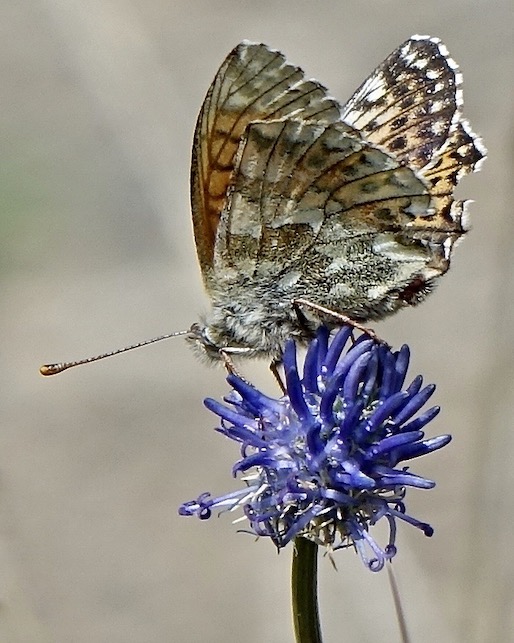 Thin black markings suggest male mountain fritillary although
it is easy to confuse with Shepherd's fritillary, form palustris
which is also found in alpine regions.
Markings on male Mountain maybe not as heavy as on Palustris.
Thin black markings suggest male mountain fritillary although
it is easy to confuse with Shepherd's fritillary, form palustris
which is also found in alpine regions.
Markings on male Mountain maybe not as heavy as on Palustris.
|
 This is a section of the wing taken from the photo on the left.
The white circled area highlights the thickness and position of a black
mark that may help to distinguish Mountain and Shepherd's.
I found this suggested diagnostic in the web-site european-butterflies.org.uk.
It is described in more detail in the section 'download for small fritillaries'.
Briefly, if this mark (in s2) is thinnish and away from the junction of v3 with
the edge of the cell, then it's a Mountain. If it's thick and very near to this
junction with the cell then it's Shepherd's.
This is a section of the wing taken from the photo on the left.
The white circled area highlights the thickness and position of a black
mark that may help to distinguish Mountain and Shepherd's.
I found this suggested diagnostic in the web-site european-butterflies.org.uk.
It is described in more detail in the section 'download for small fritillaries'.
Briefly, if this mark (in s2) is thinnish and away from the junction of v3 with
the edge of the cell, then it's a Mountain. If it's thick and very near to this
junction with the cell then it's Shepherd's.
Interestingly, Collins field-guide does show this detail in its colour
plates of the two species.
In my view, this fact gives significant weight to the diagnostic.
|
 Arguably, the underside is a bit dull and sandy looking.
The white areas are not that well defined.
Hence this specimen more closely resembles Mountain.
Arguably, the underside is a bit dull and sandy looking.
The white areas are not that well defined.
Hence this specimen more closely resembles Mountain.
|





